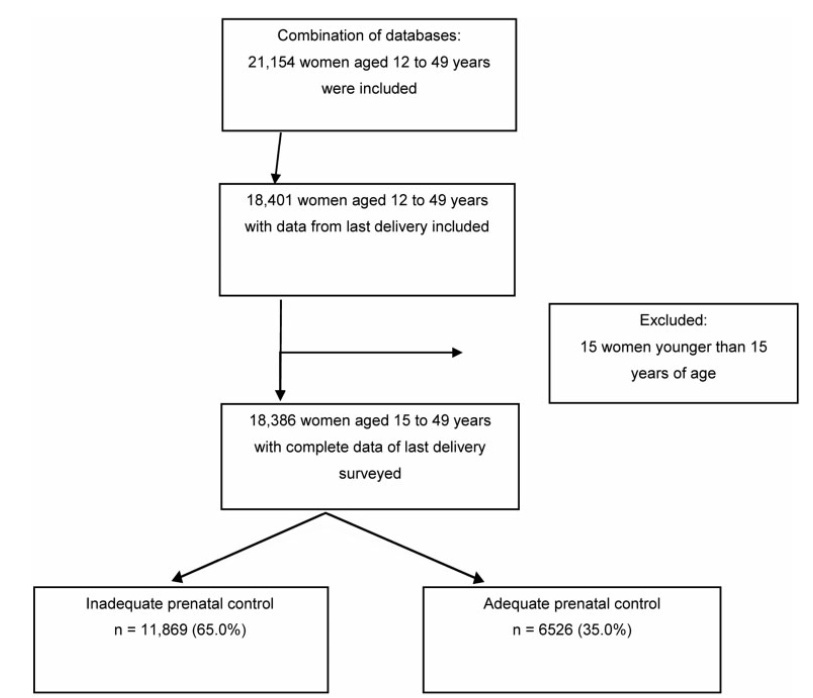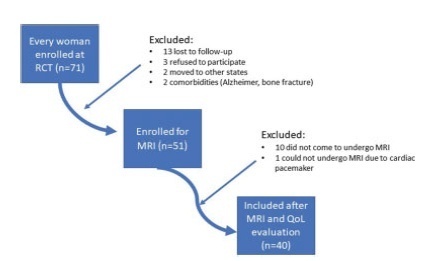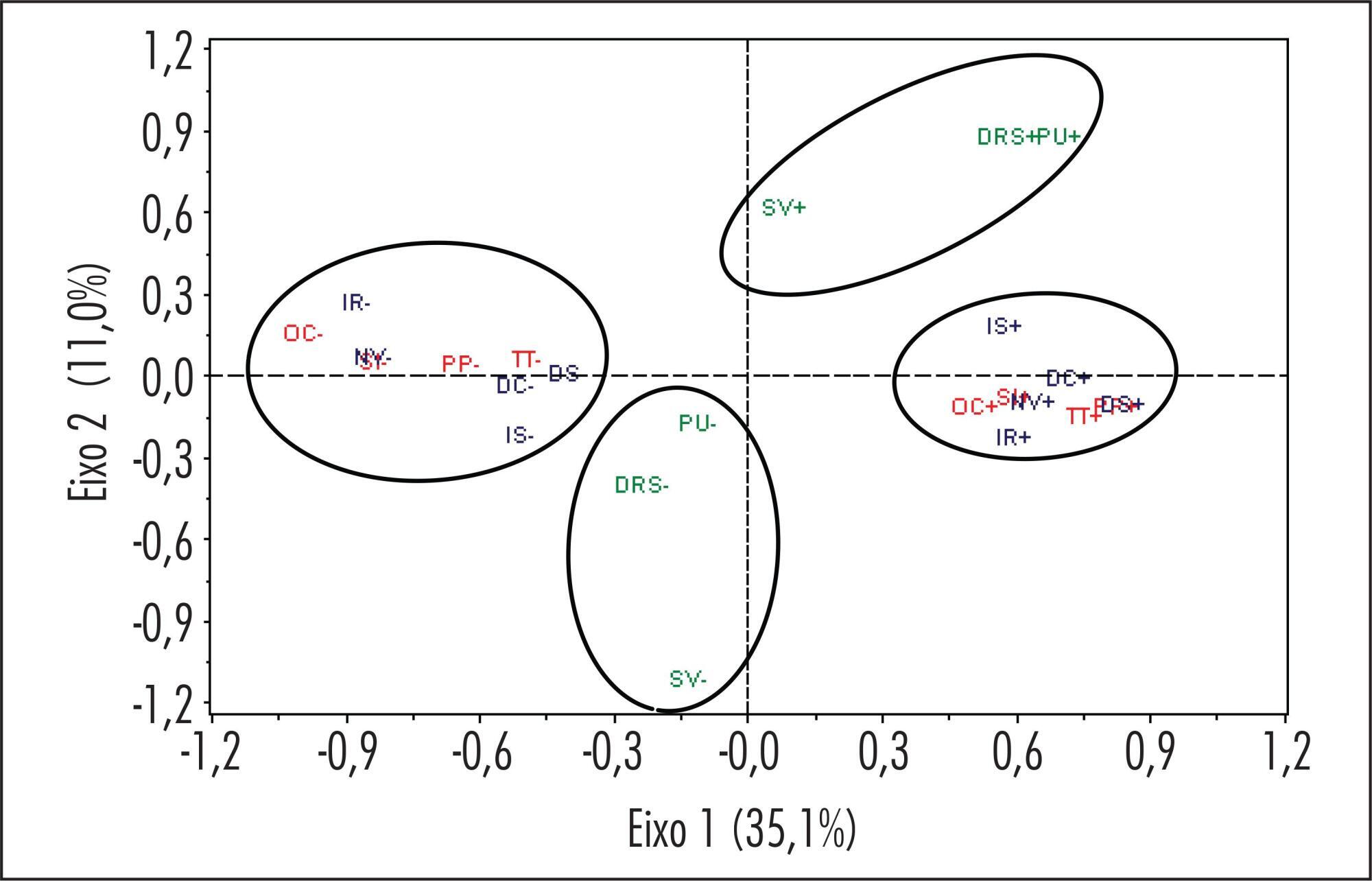Summary
Rev Bras Ginecol Obstet. 2022;44(2):133-141
To investigate the prevalence of premenstrual syndrome (PMS) and premenstrual dysphoric disorder (PMDD) in university students, the factors associated with PMS, the most prevalent symptoms, and the interference of symptoms in academic, family, social, and work activities.
This cross-sectional study included 1,115 university students aged ≥ 18 years from the University of Rio Verde, Goiás. Premenstrual syndrome and PMDD were identified using the Premenstrual Symptoms Screening Tool. Associations with sociodemographic, behavioral, reproductive, nutritional, and health factors were investigated using the Poisson regression.
The prevalence of PMS was 46.9% (95% confidence interval [CI] 44.0-49.8), and of PMDD, 11.1% (95% CI 9.3-13.0). The most prevalent symptoms were physical, such as breast tenderness, bloating, e weight gain (73%); followed by psychological ones such as overeating/food cravings, tearful/more sensitive to rejection (> 60%). More than 30% of the patients reported that the symptoms interfered in a moderate-tosevere way in their social and academic activities. After adjusted analysis, PMS was more prevalent in those who were attending the 1st/2nd semester of college (prevalence ratio [PR] 1.44; 95% CI 1.14-1.80), those who consumed alcohol in the last 30 days (PR 1.23; 95% CI 1.04-1.47), and those who had depression (PR 1.49; 95% CI 1.30-1.71).
Almost half of the university students had PMS and ~ 11%, PMDD. Physical symptoms were themost common and interfered in amoderate-to-severe way in various aspects of life. Attending the first semesters, consuming alcohol, and having depression were risk factors for PMS. The identification of risk factors for PMS is essential to prevent symptoms and reduce the impact of the syndrome.
Summary
Rev Bras Ginecol Obstet. 2021;43(9):676-681
To assess the most common psychological disturbances in women with deep endometriosis and bowel involvement who are waiting surgical treatment and to evaluate what forms of coping are used to solve the problem.
This was a cross-sectional observational study of 40 women diagnosed with deep endometriosis and intestinal symptoms. They completed two questionnaires: one for anxiety and depression (Hospital Anxiety and Depression Scale [ HADS]) and the Scale of Mode of Confronting Problems (EMEP, in the Portuguese acronym).
We found that 77.1% of the patients had anxiety and depression, with anxiety being the most prevalent (87.5% of the patients); 90% of the patients used problem focused and religious introspection as their main modes of confronting problems.
In the use of the HADS questionary, two psychological aspects were the most present in women with deep endometriosis awaiting surgical treatment: anxiety and depression. The most used forms of coping to solve the problem were problem coping and religious practices.
Summary
Rev Bras Ginecol Obstet. 2021;43(6):442-451
To determine the adequacy of compliance with antenatal care (ANC) by pregnant women in Peru and to identify the associated factors.
An analytical cross-sectional study of data from the 2019 Peruvian Demographic and Family Health Survey (Encuesta Demográfica y de Salud Familiar, ENDES, in Spanish) was conducted. The dependent variable was adequate compliance with ANC (provided by skilled health care professionals; first ANC visit during the first trimester of pregnancy; six or more ANC visits during pregnancy; ANC visits with appropriate content) by women aged 15 to 49 years in their last delivery within the five years prior to the survey. Crude and adjusted prevalence ratios and their 95% confidence intervals were calculated using a log-binomial regression model.
A total of 18,386 women were analyzed, 35.0% of whom adequately complied with ANC. The lowest proportion of compliance was found with the content of ANC (42.6%). Sociodemographic factors and those related to pregnancy, such as being in the age groups of 20 to 34 years and 35 to 49 years, havingsecondaryor higher education, belonging to a wealth quintile of the population other than the poorest, being from the Amazon region, not being of native ethnicity, having a second or third pregnancy, and having a desired pregnancy, increased the probability of presenting adequate compliance with ANC.
Only 3 out of 10women in Peru showed adequate compliancewith ANC. Compliance with the content of ANC must be improved, and strategies must be developed to increase the proportion of adequate compliance with ANC.

Summary
Rev Bras Ginecol Obstet. 2021;43(1):46-53
Magnetic resonance imaging (MRI) has been considered another tool for use during the pre- and postoperative periods of the management of pelvic-organ prolapse (POP). However, there is little consensus regarding its practical use for POP and the association betweenMRI lines of reference and physical examination.We aimedto evaluate the mid- to long-term results of two surgical techniques for apical prolapse.
In total, 40 women with apical POP randomized from 2014 to 2016 underwent abdominal sacrocolpopexy (ASC group; n = 20) or bilateral vaginal sacrospinous fixation with an anterior mesh (VSF-AM group; n = 20). A physical examination using the POP Quantification System (POP-Q) for staging (objective cure) and the International Consultation on Incontinence Questionnaire-Vaginal Symptoms (ICIQ-VS: subjective cure), were applied and analyzed before and one year after surgery respectively. All MRI variables (pubococcigeous line [PCL], bladder base [BB], anorectal junction [ARJ], and the estimated levator ani subtended volume [eLASV]) were investigated one year after surgery. Significance was established at p < 0.05.
After a mean 27-month follow-up, according to the MRI criteria, 60% of the women were cured in the VSF-AM group versus 45% in ASC group (p= 0.52). The POP-Q and objective cure rates by MRI were correlated in the anterior vaginal wall (p= 0.007), but no correlationwas foundwith the subjective cure. The eLASVwas largeramongthe patients with surgical failure, and a cutoff of ≥ 33.5mm3 was associated with postoperative failure (area under the receiver operating characteristic curve [ROC]: 0.813; p= 0.002).
Both surgeries for prolapse were similar regarding theobjective variables (POP-Q measurements and MRI cure rates). Larger eLASV areas were associated with surgical failure.

Summary
Rev Bras Ginecol Obstet. 2019;41(4):242-248
To analyze the factors associated with health-related quality of life (HRQoL) in women with cervical cancer (CC) in a single center in Rio de Janeiro, state of Rio de Janeiro, Brazil.
A cross-sectional study in women with a diagnosis of CC followed-up in the gynecology outpatient clinic of the Hospital do Câncer II (HCII, in the Portuguese acronym) of the Instituto Nacional de Câncer (INCA, in the Portuguese acronym). The data were collected from March to August 2015. Women with palliative care, communication/cognition difficulty, undergoing simultaneous treatment for other types of cancer, or undergoing chemotherapy and/or radiation therapy were excluded. For the evaluation of the HRQoL, a specific questionnaire for women with CC was used (Functional Assessment of Cancer Therapy - Cervix Cancer [FACT-Cx]). The total score of the questionnaire ranges from 0 to 168, with higher scores indicating a better HRQoL.
A total of 115 women were included in the present study, with a mean age of 52.64 years old (standard deviation [SD] = 12.13). The domains of emotional (16.61; SD = 4.55) and functional well-being (17.63; SD = 6.15) were those which presented the worst scores. The factors that had an association with better HRQoL in women with CC were having a current occupation, a longer time since the treatment and diagnosis, and women who had undergone hysterectomy.
Considering the domains of HRQoL of the women treated for cervical cancer, a better score was observed in the domains of physical and social/family wellbeing. For most domains, better scores were found between those with a current occupation, with a longer time after the diagnosis and treatment, and among those who had undergone a hysterectomy.
Summary
Rev Bras Ginecol Obstet. 2016;38(6):293-300
To assess the prevalence of depressive symptoms and their association with social, psychological, behavioral and obstetric characteristics in pregnant women.
This is a cross-sectional study. The sample consisted of 375 pregnant women who attended prenatal clinics in two public maternity hospitals located in the city of Goiania, Brazil. To testify the depressive symptoms, we used the Hospital Anxiety and Depression Scale (HADS). A descriptive statistical analysis was performed using programs such as CDC EPI-INFO(tm), version 7.1.5, and Statistical Package for Social Sciences (IBM SPSS), version 21.0.
the patients had probable depressive symptoms (15.47%) and possible depressive symptoms (25.33%). The bivariate analysis showed a significant association among "depressive symptoms" and the following variables: "single or divorced" (prevalence ratio, PR = 2.08; 95% confidence interval, CI = 1.26 to 3.44); "physical activity during pregnancy" (PR = 3.96; 95%CI = 1.28 to 12.31); exposure to "psychological/emotional" violence (PR = 4.74; 95%CI = 2.94 to 7.64); "prior mental problem" (PR = 2.66; 95%CI =1.49 to 4.73) and "obstetric complications during pregnancy" (PR = 2.53; 95%CI = 1.55 to 4.13). The multivariate analysis confirmed the association of these depressive symptoms with the variables "suffered psychological/emotional violence" (odds ratio, OR = 5.821; 95%CI = 2.939 to 11.528); "physical activity during pregnancy" (OR = 3.885; 95%CI = 1.060 to 14.231); "obstetric complications during pregnancy" (OR = 2.442; 95%CI = 1.233 to 4.834) and "single or divorced" (OR = 2.943; 95%CI = 1.326 to 6.533).
the prevalence of depressive symptoms among pregnant women is of 15.47%, and emotional violence is the main factor associated with gestational depression.
Summary
Rev Bras Ginecol Obstet. 2014;36(4):163-169
DOI 10.1590/S0100-7203201400040002
To assess the prevalence of Climacteric Syndrome (CS) in women from a municipality of Northeastern Brazil which is less developed socioeconomically.
A prospective household survey was performed in São Luís, Maranhão, Brazil with 1,210 climacteric women aged 45 to 60 years. Interviews were applied using previously tested standard questionnaires from April to July 2008. The severity of climacteric symptoms was analyzed by circulatory and psychological indexes and the latter were associated with menopausal status. Multiple correspondence analysis was used to assess the relation among climacteric symptoms.
Most patients were 55 to 60 years old (35.3%), mulatto (37.9%), with 9-11 years of schooling (39.8%), with a partner (56%), Catholic (73.9%) and belonged to the socioeconomic class C (51.1%). The prevalence of CS was 85.9%, and hot flashes (56.4%) and sweating (50.4%) were the most prevalent symptoms. The most frequent psychological symptoms were nervousness (45%) and emotional liability (44.8%). The severity of vasomotor and psychological symptoms was significantly higher during the peri and postmenopausal period (p<0.05). Vaginal dryness (62.7%) was the most prevalent urogenital complaint.
The prevalence of CS was high among women from São Luís, Maranhão, Brazil.

Summary
Rev Bras Ginecol Obstet. 2012;34(9):432-437
DOI 10.1590/S0100-72032012000900008
PURPOSE: To verify the coverage, by Pap testing, of older women and the associated factors. METHODS: A population-based study was conducted by home interviews. The inclusion criteria were women aged 60 and over, living on the north side of the city of Juiz de Fora, Minas Gerais, Brazil, self-sufficient to answer the questionnaire or having someone to answer on their behalf. The interview consisted of sociodemographic questions, regarding the general health of the older women, and preventive practices in women's health. The selection was made by random sampling, stratified and clustered in multiple stages. To analyze associated factors, a theoretical model was formulated with three hierarchical blocks of variables, adjusted to each other in each block. The variables that had a level of significance of 0.2 or less were included in the Poisson regression model and adjusted to their next highest level (p<0.1). RESULTS: Pap testing occurred in 84.1% of cases (95%CI 79.0-88.4). Based on multivariate regression analysis, three variables remained significantly associated with access to Pap testing: the marital status "without partner" (older women who were single, widowed, separated or divorced), self-sufficiency to perform Instrumental Activities of Daily Living (IADLs) and adherence to mammography. In the interblock analysis these variables remained significantly associated with the outcome variable, and self-sufficiency for IADLs had the highest association. CONCLUSIONS: Among the older women comprising the study sample, was observed variation in the use of Pap testing. An adjustment of public health policies towards the formulation of policies giving priority to universal preventive care may be an alternative to solve the disparities observed.
Search
Search in:
breast (42) breast cancer (42) breast neoplasms (95) Cesarean section (72) endometriosis (66) infertility (56) Maternal mortality (43) menopause (82) obesity (58) postpartum period (40) pregnancy (225) Pregnancy complications (99) Prenatal care (68) prenatal diagnosis (50) Prevalence (41) Quality of life (51) risk factors (94) ultrasonography (79) urinary incontinence (40) women's health (48)